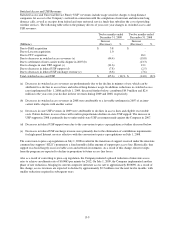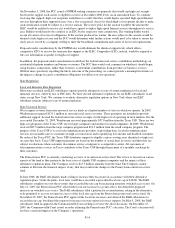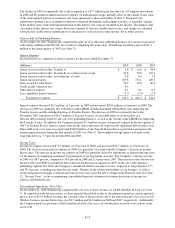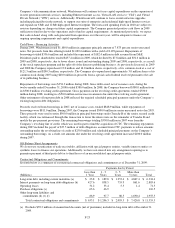Windstream 2009 Annual Report Download - page 128
Download and view the complete annual report
Please find page 128 of the 2009 Windstream annual report below. You can navigate through the pages in the report by either clicking on the pages listed below, or by using the keyword search tool below to find specific information within the annual report.
(b) Depreciation expense decreased in 2008 primarily due to the completion of studies of the Company’s depreciable
lives during 2007. Depreciable lives were revised to reflect the estimated remaining useful lives of wireline plant
based on the Company’s expected future network utilization and capital expenditure levels required to provide
service to its customers (see Note 2).
Restructuring Charges
Restructuring charges, consisting primarily of severance and employee benefit costs, are triggered by the Company’s
continued evaluation of its operating structure and identification of opportunities for increased operational efficiency
and effectiveness. These costs should not necessarily be viewed as non-recurring. They are reviewed regularly by the
Company’s decision makers and are included as a component of compensation targets.
During the year ended December 31, 2009, Windstream recognized $9.3 million in severance and employee benefit
costs primarily related to the workforce reduction initiated during the third quarter of 2009 to better align the
Company’s focus on high-speed Internet and enterprise opportunities. The Company expects to realize annual savings
of approximately $20.0 million as a result of this initiative. During the first quarter of 2009, the Company recorded a
$0.1 million reduction in liabilities to reflect differences between estimated and actual costs paid associated with a
work force reduction initiated during the fourth quarter of 2008. During the second quarter of 2009, the Company
incurred $0.1 million in severance and employee benefit costs associated with the closure of an out of territory sales
and product distribution facility.
During the year ended December 31, 2008, the Company incurred $8.5 million in severance and employee benefit
costs primarily related to the announced workforce reduction in the fourth quarter of 2008 to control expenses in a
challenging economy and the realignment of certain information technology, network operations and business sales
functions.
Merger and Integration Costs
Merger and integration costs are unpredictable by nature, and include costs incurred related to strategic transactions
such as transaction costs, rebranding costs, system conversion costs and employee related transaction costs (see Note
10). Set forth below is a summary of merger and integration costs for the years ended December 31:
(Millions) 2009 2008 2007
Wireline Segment
Merger and integration costs
Transaction costs associated with acquisitions $ 11.4 $ 0.1 $ 0.7
Employee related transaction costs 8.6 - -
Computer system and conversion costs 1.6 6.1 2.5
Signage and other rebranding costs 0.7 - 1.3
Total wireline merger and integration costs $ 22.3 $ 6.2 $ 4.5
Regulatory Matters
Our incumbent local exchange carrier subsidiaries (collectively the “ILECs”) are regulated by both federal and state
agencies. Our interstate products and services and the related earnings are subject to federal regulation by the Federal
Communications Commission (“FCC”) and our local and intrastate products and services and the related earnings are
subject to regulation by state Public Service Commissions (“PSCs”). The FCC has principal jurisdiction over matters
including, but not limited to, interstate switched and special access rates, as well as high-speed Internet service
offerings. It also regulates the rates that ILECs may charge for the use of their local networks in originating or
terminating interstate and international transmissions. The PSCs have jurisdiction over matters including local service
rates, intrastate access rates, quality of service, the disposition of public utility property and the issuance of securities
or debt by the local operating companies.
Federal Regulation and Legislation
Communications services providers are regulated differently depending primarily upon the network technology used to
deliver the service. This patchwork regulatory approach advantages certain companies and disadvantages others. It
impedes market-based competition where service providers using different technologies exchange telecommunications
traffic and compete for customers.
From time to time federal legislation is introduced dealing with various matters that could affect our business. Most
proposed legislation of this type never becomes law. It is difficult to predict what kind of reform efforts, if any, may be
introduced in Congress and ultimately become law. Windstream strongly supports the modernization of the nation’s
telecommunications laws, but at this time, cannot predict the timing and the resulting financial impact of any possible
federal legislative efforts.
F-14
























